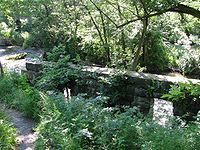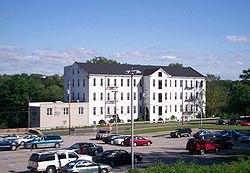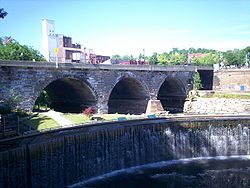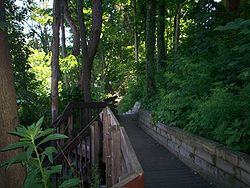
Kent Industrial District
Encyclopedia
The Kent Industrial District is a historic district
in Kent
, Ohio
, United States
, listed on the National Register of Historic Places
. The district covers around 43 acres (17.4 ha) of downtown Kent on either side of the Cuyahoga River
and is roughly bounded by West Main Street on the north, River Street to the west, Franklin Avenue to the east and Haymaker Parkway to the south. Within the district are three buildings and two stone structures of historical significance. It was listed on the National Register of Historic Places
in 1974. Kent namesake Marvin Kent
was involved in several aspects of the district's development and the area would play a key role in the development of Kent during much of the 19th century. The earliest structures in the district date to the 1830s with the most recent historic structure, the livery and carriage shop building, dating to 1910. The area today is occupied mostly by the city of Kent's Franklin Mills Riveredge Park, Heritage Park, and various private landowners.
 The area that now comprises the historic district was attractive to early settlers due to potential power from the Cuyahoga River
The area that now comprises the historic district was attractive to early settlers due to potential power from the Cuyahoga River
. John Haymaker
, the first white settler in what is now Kent, built the first gristmill
along the river just north of present day Stow Street in 1807. Development along the river did not begin to pick up until the late 1830s with the construction of the Pennsylvania and Ohio Canal
and the hopes that the village, then known as Franklin Mills, would become a center for the production of silk
. These events led to rampant land speculation along the river and resulted in the construction of much of what is today downtown Kent. The Panic of 1837
and the area's unfavorable climate for silkworms ended any hopes for the village becoming a silk industrial center. It was during this time, however, that the first parts of today's historical district were constructed. As part of the canal, a 19-foot stone arch dam was constructed with an attached lock in 1836. Zenas Kent, father of Kent namesake Marvin Kent
, built a flour mill in 1837 on the site of the Haymaker's first mill, just south of the current district's boundaries. He also built a tannery across the street from the mill which he operated with John Brown
for a short time.
 In one of his first ventures as a businessman, Marvin Kent
In one of his first ventures as a businessman, Marvin Kent
helped organize a group of investors to form the Franklin Mills Cotton Company in 1851. The group set out building a factory on the site of the silk mill, which had only been excavated in the 1830s before being abandoned. The exterior of the building was completed by the summer of 1852, but shortly thereafter the main investors pulled out and the company collapsed. Only the outside of the five-story building was completed while the inside remained unfinished for over twenty years. In 1878, James Turner came from Jamestown, New York
to seek a new location for an alpaca
mill. After agreements were put in place with Marvin Kent, construction started on improvements to the building, which included a finished interior and a new water wheel for power. The mill opened September 4, 1879 and later included worsted
goods. It would operate there for 10 years before moving to Cleveland
in 1889.
 Another venture of Marvin Kent
Another venture of Marvin Kent
was the establishment of the Atlantic and Great Western Railroad
and his role in having Franklin Mills selected not only as a stop on the line, but also as the location for the railroad shops. This led to construction of railroad tracks through what is now the eastern edge of the historic district beginning in 1853 and later the construction of a train station, which would open June 1, 1875. Soon after, in 1876, construction began on a replacement of the Main Street bridge, which previously had been a wooden covered bridge built in 1837. A stone arch bridge was built, which was completed in 1877. During the 1880s a second rail line was constructed through the current district by the Baltimore and Ohio Railroad
, known today as the "lower tracks."
 After the departure of the alpaca-worsted mill in 1889, the area which now comprises the historic district slowly declined in importance. The lock and dam were heavily damaged in 1913 during a flood that affected much of Ohio
After the departure of the alpaca-worsted mill in 1889, the area which now comprises the historic district slowly declined in importance. The lock and dam were heavily damaged in 1913 during a flood that affected much of Ohio
. The damage was heavy enough to cause residents to debate whether or not the dam and lock should be repaired or removed. Ultimately, they were repaired in 1925 due to their historic value. The Kent flour mill and Kent tannery (also known as the John Brown tannery) fell into disuse. The mill was torn down in the 1930s while the tannery lasted until 1976 when it was torn down as part of an environmental cleanup project. Also during the 1930s, land was donated to the city to create Franklin Mills Riveredge Park, which covers much of the current historical district along with Tannery Park, which occupies the site of tannery. The park features a boardwalk
along the Cuyahoga River which closely follows the path of the mill race
which originally ran from the dam to the flour and alpaca mills downstream.
Around 1910, a livery and carriage shop was built at the southeast corner of West Main and River Streets. This building would later serve as an automobile dealership in the 1970s and is today home to several offices.
The Atlantic and Great Western Rail Depot, later known as the Erie Depot, continued to be used as a train depot until January 6, 1970. At that point it was abandoned and boarded up. Its potential demolition in the early 1970s was one of the first major projects of the Kent Historical Society, formed in 1971, which purchased the building in 1975 and renovated it, occupying the second floor along with the Kent Chamber of Commerce until 2006. Just prior to purchasing the building, the historic district was formed which included the depot, being listed on the National Register of Historic Places
on December 30, 1974. In 1981, the Pufferbelly Restaurant moved in to the lower floor of the old depot and continues to operate there. Also during the early 1970s, Haymaker Parkway was constructed. The main bridge of the parkway, known as the Redmond Greer Memorial Bridge, essentially forms the southern boundary of the district, immediately south of the former alpaca mill.
 In 2002, the former alpaca-worsted mill, known locally as the silk mill, was purchased by a developer and renovated into several loft apartments. The building had previously been used as a warehouse. In 2004 the Ohio Environmental Protection Agency declared the Cuyahoga River
In 2002, the former alpaca-worsted mill, known locally as the silk mill, was purchased by a developer and renovated into several loft apartments. The building had previously been used as a warehouse. In 2004 the Ohio Environmental Protection Agency declared the Cuyahoga River
water quality to be too low and recommended removal of the dam. In a compromise of environmental and historical concerns, one wall of the lock was removed and the channel was widened to allow the river to flow through it. Behind the dam, a small park known as Heritage Park was constructed which included a large pump to allow water to be pumped over the dam during warm-weather months. It was dedicated in May 2005.
Historic district (United States)
In the United States, a historic district is a group of buildings, properties, or sites that have been designated by one of several entities on different levels as historically or architecturally significant. Buildings, structures, objects and sites within a historic district are normally divided...
in Kent
Kent, Ohio
Kent is a city in the U.S. state of Ohio and the largest city in Portage County. It is located along the Cuyahoga River in Northeastern Ohio on the western edge of the county. The population was 27,906 at the 2000 United States Census and 28,904 in the 2010 Census...
, Ohio
Ohio
Ohio is a Midwestern state in the United States. The 34th largest state by area in the U.S.,it is the 7th‑most populous with over 11.5 million residents, containing several major American cities and seven metropolitan areas with populations of 500,000 or more.The state's capital is Columbus...
, United States
United States
The United States of America is a federal constitutional republic comprising fifty states and a federal district...
, listed on the National Register of Historic Places
National Register of Historic Places
The National Register of Historic Places is the United States government's official list of districts, sites, buildings, structures, and objects deemed worthy of preservation...
. The district covers around 43 acres (17.4 ha) of downtown Kent on either side of the Cuyahoga River
Cuyahoga River
The Cuyahoga River is located in Northeast Ohio in the United States. Outside of Ohio, the river is most famous for being "the river that caught fire", helping to spur the environmental movement in the late 1960s...
and is roughly bounded by West Main Street on the north, River Street to the west, Franklin Avenue to the east and Haymaker Parkway to the south. Within the district are three buildings and two stone structures of historical significance. It was listed on the National Register of Historic Places
National Register of Historic Places
The National Register of Historic Places is the United States government's official list of districts, sites, buildings, structures, and objects deemed worthy of preservation...
in 1974. Kent namesake Marvin Kent
Marvin Kent
Marvin Kent was a railroad president and businessman from Portage County, Ohio, USA, and namesake of the city of Kent, Ohio, which was previously known as Franklin Mills.-Biography:...
was involved in several aspects of the district's development and the area would play a key role in the development of Kent during much of the 19th century. The earliest structures in the district date to the 1830s with the most recent historic structure, the livery and carriage shop building, dating to 1910. The area today is occupied mostly by the city of Kent's Franklin Mills Riveredge Park, Heritage Park, and various private landowners.
Early development

Cuyahoga River
The Cuyahoga River is located in Northeast Ohio in the United States. Outside of Ohio, the river is most famous for being "the river that caught fire", helping to spur the environmental movement in the late 1960s...
. John Haymaker
John Haymaker
John Haymaker was an early settler of Ohio and the founder of Franklin Township and what would become the city of Kent, Ohio. Haymaker and his family, who were of German descent, moved west from Pittsburgh to Franklin Township in the Connecticut Western Reserve on the banks of the Cuyahoga River...
, the first white settler in what is now Kent, built the first gristmill
Gristmill
The terms gristmill or grist mill can refer either to a building in which grain is ground into flour, or to the grinding mechanism itself.- Early history :...
along the river just north of present day Stow Street in 1807. Development along the river did not begin to pick up until the late 1830s with the construction of the Pennsylvania and Ohio Canal
Pennsylvania and Ohio Canal
The Pennsylvania and Ohio Canal, also known as the P & O Canal, the Cross Cut Canal and the Mahoning Canal was a shipping canal which operated from 1840 until 1877...
and the hopes that the village, then known as Franklin Mills, would become a center for the production of silk
Silk
Silk is a natural protein fiber, some forms of which can be woven into textiles. The best-known type of silk is obtained from the cocoons of the larvae of the mulberry silkworm Bombyx mori reared in captivity...
. These events led to rampant land speculation along the river and resulted in the construction of much of what is today downtown Kent. The Panic of 1837
Panic of 1837
The Panic of 1837 was a financial crisis or market correction in the United States built on a speculative fever. The end of the Second Bank of the United States had produced a period of runaway inflation, but on May 10, 1837 in New York City, every bank began to accept payment only in specie ,...
and the area's unfavorable climate for silkworms ended any hopes for the village becoming a silk industrial center. It was during this time, however, that the first parts of today's historical district were constructed. As part of the canal, a 19-foot stone arch dam was constructed with an attached lock in 1836. Zenas Kent, father of Kent namesake Marvin Kent
Marvin Kent
Marvin Kent was a railroad president and businessman from Portage County, Ohio, USA, and namesake of the city of Kent, Ohio, which was previously known as Franklin Mills.-Biography:...
, built a flour mill in 1837 on the site of the Haymaker's first mill, just south of the current district's boundaries. He also built a tannery across the street from the mill which he operated with John Brown
John Brown (abolitionist)
John Brown was an American revolutionary abolitionist, who in the 1850s advocated and practiced armed insurrection as a means to abolish slavery in the United States. He led the Pottawatomie Massacre during which five men were killed, in 1856 in Bleeding Kansas, and made his name in the...
for a short time.
Alpaca Mill

Marvin Kent
Marvin Kent was a railroad president and businessman from Portage County, Ohio, USA, and namesake of the city of Kent, Ohio, which was previously known as Franklin Mills.-Biography:...
helped organize a group of investors to form the Franklin Mills Cotton Company in 1851. The group set out building a factory on the site of the silk mill, which had only been excavated in the 1830s before being abandoned. The exterior of the building was completed by the summer of 1852, but shortly thereafter the main investors pulled out and the company collapsed. Only the outside of the five-story building was completed while the inside remained unfinished for over twenty years. In 1878, James Turner came from Jamestown, New York
Jamestown, New York
Jamestown is a city in Chautauqua County, New York in the United States. The population was 31,146 at the 2010 census.The City of Jamestown is adjacent to Town of Ellicott and is at the southern tip of Chautauqua Lake...
to seek a new location for an alpaca
Alpaca
An alpaca is a domesticated species of South American camelid. It resembles a small llama in appearance.Alpacas are kept in herds that graze on the level heights of the Andes of southern Peru, northern Bolivia, Ecuador, and northern Chile at an altitude of to above sea level, throughout the year...
mill. After agreements were put in place with Marvin Kent, construction started on improvements to the building, which included a finished interior and a new water wheel for power. The mill opened September 4, 1879 and later included worsted
Worsted
Worsted , is the name of a yarn, the cloth made from this yarn, and a yarn weight category. The name derives from the village of Worstead in the English county of Norfolk...
goods. It would operate there for 10 years before moving to Cleveland
Cleveland, Ohio
Cleveland is a city in the U.S. state of Ohio and is the county seat of Cuyahoga County, the most populous county in the state. The city is located in northeastern Ohio on the southern shore of Lake Erie, approximately west of the Pennsylvania border...
in 1889.
Railroad and bridge

Marvin Kent
Marvin Kent was a railroad president and businessman from Portage County, Ohio, USA, and namesake of the city of Kent, Ohio, which was previously known as Franklin Mills.-Biography:...
was the establishment of the Atlantic and Great Western Railroad
Atlantic and Great Western Railroad
The Atlantic and Great Western Railroad began as three separate railroads: the Erie and New York City Railroad based in Jamestown, New York; the Meadville Railroad based in Meadville, Pennsylvania ; and the Franklin and Warren Railroad based in Franklin Mills, Ohio...
and his role in having Franklin Mills selected not only as a stop on the line, but also as the location for the railroad shops. This led to construction of railroad tracks through what is now the eastern edge of the historic district beginning in 1853 and later the construction of a train station, which would open June 1, 1875. Soon after, in 1876, construction began on a replacement of the Main Street bridge, which previously had been a wooden covered bridge built in 1837. A stone arch bridge was built, which was completed in 1877. During the 1880s a second rail line was constructed through the current district by the Baltimore and Ohio Railroad
Baltimore and Ohio Railroad
The Baltimore and Ohio Railroad was one of the oldest railroads in the United States and the first common carrier railroad. It came into being mostly because the city of Baltimore wanted to compete with the newly constructed Erie Canal and another canal being proposed by Pennsylvania, which...
, known today as the "lower tracks."
Later history

Ohio
Ohio is a Midwestern state in the United States. The 34th largest state by area in the U.S.,it is the 7th‑most populous with over 11.5 million residents, containing several major American cities and seven metropolitan areas with populations of 500,000 or more.The state's capital is Columbus...
. The damage was heavy enough to cause residents to debate whether or not the dam and lock should be repaired or removed. Ultimately, they were repaired in 1925 due to their historic value. The Kent flour mill and Kent tannery (also known as the John Brown tannery) fell into disuse. The mill was torn down in the 1930s while the tannery lasted until 1976 when it was torn down as part of an environmental cleanup project. Also during the 1930s, land was donated to the city to create Franklin Mills Riveredge Park, which covers much of the current historical district along with Tannery Park, which occupies the site of tannery. The park features a boardwalk
Boardwalk
A boardwalk, in the conventional sense, is a wooden walkway for pedestrians and sometimes vehicles, often found along beaches, but they are also common as paths through wetlands, coastal dunes, and other sensitive environments....
along the Cuyahoga River which closely follows the path of the mill race
Mill race
A mill race, raceway or mill lade is the current or channel of a stream, especially one for conducting water to or from a water wheel or other device for utilizing its energy...
which originally ran from the dam to the flour and alpaca mills downstream.
Around 1910, a livery and carriage shop was built at the southeast corner of West Main and River Streets. This building would later serve as an automobile dealership in the 1970s and is today home to several offices.
The Atlantic and Great Western Rail Depot, later known as the Erie Depot, continued to be used as a train depot until January 6, 1970. At that point it was abandoned and boarded up. Its potential demolition in the early 1970s was one of the first major projects of the Kent Historical Society, formed in 1971, which purchased the building in 1975 and renovated it, occupying the second floor along with the Kent Chamber of Commerce until 2006. Just prior to purchasing the building, the historic district was formed which included the depot, being listed on the National Register of Historic Places
National Register of Historic Places
The National Register of Historic Places is the United States government's official list of districts, sites, buildings, structures, and objects deemed worthy of preservation...
on December 30, 1974. In 1981, the Pufferbelly Restaurant moved in to the lower floor of the old depot and continues to operate there. Also during the early 1970s, Haymaker Parkway was constructed. The main bridge of the parkway, known as the Redmond Greer Memorial Bridge, essentially forms the southern boundary of the district, immediately south of the former alpaca mill.

Cuyahoga River
The Cuyahoga River is located in Northeast Ohio in the United States. Outside of Ohio, the river is most famous for being "the river that caught fire", helping to spur the environmental movement in the late 1960s...
water quality to be too low and recommended removal of the dam. In a compromise of environmental and historical concerns, one wall of the lock was removed and the channel was widened to allow the river to flow through it. Behind the dam, a small park known as Heritage Park was constructed which included a large pump to allow water to be pumped over the dam during warm-weather months. It was dedicated in May 2005.
Contributing structures
- Stone arch dam and canal lock, built 1836
- Alpaca-worsted mill (also known as the Silk Mill), built 1851
- Atlantic and Great Western Rail Depot (also known as the Erie Depot), built 1875
- Main Street Bridge, built 1877
- Livery and carriage shop, built ca. 1910
See also
- Atlantic and Great Western RailroadAtlantic and Great Western RailroadThe Atlantic and Great Western Railroad began as three separate railroads: the Erie and New York City Railroad based in Jamestown, New York; the Meadville Railroad based in Meadville, Pennsylvania ; and the Franklin and Warren Railroad based in Franklin Mills, Ohio...
- History of Kent, OhioHistory of Kent, OhioThe area now occupied by the city of Kent, Ohio, was previously inhabited by various Native American tribes until the 19th century. Though no record of any settlement exists, the area was located along several known trails. In 1798 it was sold to Aaron Olmstead as part of the Connecticut Western...
- National Register of Historic Places listings in Portage County, Ohio
- Pennsylvania and Ohio CanalPennsylvania and Ohio CanalThe Pennsylvania and Ohio Canal, also known as the P & O Canal, the Cross Cut Canal and the Mahoning Canal was a shipping canal which operated from 1840 until 1877...

